Tylopilus felleus (Bull.) P. Karst. - Bitter Bolete
Phylum: Basidiomycota - Class: Agaricomycetes - Order: Boletales - Family: Boletaceae
Distribution - Taxonomic History- Etymology - Identification - Culinary Notes - Reference Sources
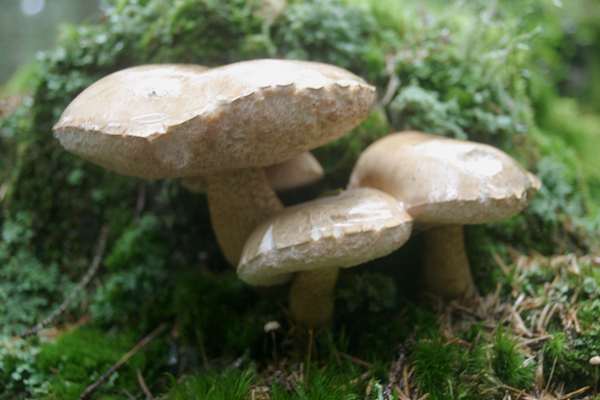
A pink flush to the pore openings betrays the identity of this inedible Cep look-alike, which is very bitter indeed (and cooking only seems to enhance the bitter taste).
If you gather Boletus edulis or other boletes for eating, it is well worth getting to know how to distinguish the Bitter Bolete from other brown-capped species that have reticulated (netted) stems. Accidentally including this imposter in a meal guarantees that it will be inedible to anyone who still has any taste buds.
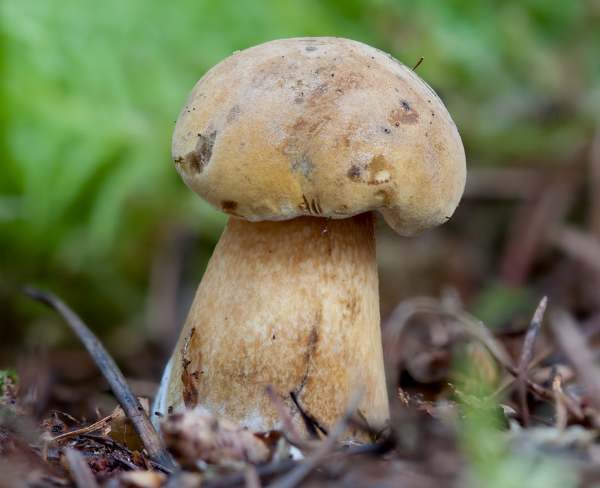
Distribution
An occasional species in Britain and Ireland, Tylopilus felleus is rather more common in northern European countries.
Taxonomic history
This bolete was first described in 1788 by Jean Baptiste François Pierre Bulliard, who gave it the scientific name Boletus felleus. Almost a century later, in 1881, Petter Adolf Karsten (1834 - 1917) transferred the Bitter Bolete to its present genus Tylopilus.
Synonyms of Tylopilus felleus include Boletus felleus Bull., Boletus alutarius Fr., and Tylopilus alutarius (Fr.) Rea.
Etymology
The specific epithet felleus comes from fel, meaning bile, and is a reference to the bitter taste of this otherwise rather attractive bolete.
Identification guide
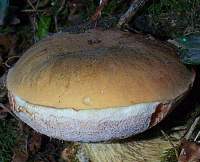 |
CapWhen young, as in the specimen shown here, the somewhat velvety cap is domed and mid brown, sometimes with an olive tinge. At maturity, the caps turn a darker shade of brown, flattening and frequently splitting and/or developing wavy edges. Typically 6 to 12cm in diameter but occasionally as large as 18cm, the caps of Tylopilus felleus gradually lose their velvet bloom as they age. |
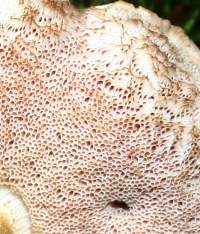 |
Tubes and PoresInitially pale cream but later turning pinkish, the tubes are round, densely packed and fairly small, terminating in palid pores spaced between 1 and 2 per mm that turn coral pink as the fruitbody matures. When handled and bruised, the delicate pores gradually turn brown. |
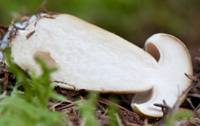 |
Cross-section of fruitbodyThe cap and stem flesh is white and does not change colour when it is cut. (Picture left is shown courtesy of Dave Kelly) |
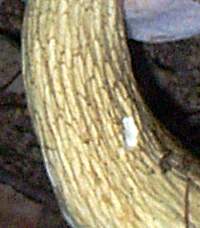 |
StemA brown net-like reticulate pattern on the stem sometimes leads to this inedible bolete being mistaken for the choice edible Cep or Penny Bun Bolete (Boletus edulis). The stem of Tylopilus felleus is 10 to 18mm in diameter, thickening towards the base, and 4 to 8cm tall. (It is frequently curved.) |
SporesSubfusiform, 11-15 x 4-5μm. Spore printClay-pink. |
|
Odour/taste |
Odour not distinctive; taste extremely bitter indeed. |
Habitat & Ecological role |
This ectomycorrhizal fungus is usually solitary but occasionally occurs in small groups beneath oak, beech or other broadleaf trees and very occasionally with coniferous trees. |
Season |
August to November in Britain and Ireland. |
Similar species |
Boletus edulis has a similar reticulate stipe but its pores do not flush coral pink. |
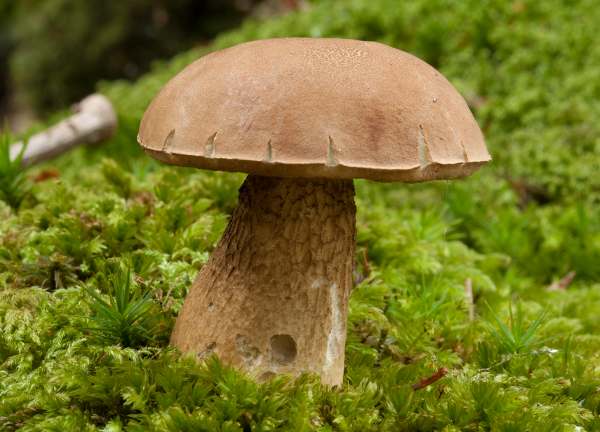
Culinary Notes
Tylopilus felleus is hot enough to be considered inedible by even the most ardent hot curry enthusiasts, but in some countries this bolete is dried and used as a substitute for pepper.
Reference Sources
Fascinated by Fungi, 2nd Edition, Pat O'Reilly 2016, reprinted by Coch-y-bonddu Books in 2022.
British Boletes, with keys to species, Geoffrey Kibby (self published) 3rd Edition 2012
Roy Watling & Hills, A.E. 2005. Boletes and their allies (revised and enlarged edition), - in: Henderson, D.M., Orton, P.D. & Watling, R. [eds]. British Fungus Flora. Agarics and boleti. Vol. 1. Royal Botanic Garden, Edinburgh.
Dictionary of the Fungi; Paul M. Kirk, Paul F. Cannon, David W. Minter and J. A. Stalpers; CABI, 2008
Taxonomic history and synonym information on these pages is drawn from many sources but in particular from the British Mycological Society's GB Checklist of Fungi.
Acknowledgements
This page includes pictures kindly contributed by David Kelly.
Fascinated by Fungi. Back by popular demand, Pat O'Reilly's best-selling 450-page hardback book is available now. The latest second edition was republished with a sparkling new cover design in September 2022 by Coch-y-Bonddu Books. Full details and copies are available from the publisher's online bookshop...

